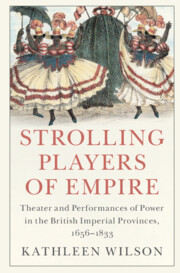 Strolling Players of Empire
Strolling Players of Empire Book contents
- Strolling Players of Empire
- Critical Perspectives on Empire
- Strolling Players of Empire
- Copyright page
- Dedication
- Epigraph
- Contents
- Figures
- Maps
- Acknowledgments
- Abbreviations
- Prologue
- Introduction
- Part I Playing
- 1 Peripheralizing the Spheres
- 2 Rowe’s Fair Penitent As Global History
- 3 The Lure of the Other
- Part II Theaters of Empire
- Part III East India Company Peripheries and the History of Modernity
- Book part
- Index
- Plate Section (PDF Only)
3 - The Lure of the Other
Jews, Nabobs and Enslaved Africans in a Transcolonial Imaginary
from Part I - Playing
Published online by Cambridge University Press: 11 November 2022
- Strolling Players of Empire
- Critical Perspectives on Empire
- Strolling Players of Empire
- Copyright page
- Dedication
- Epigraph
- Contents
- Figures
- Maps
- Acknowledgments
- Abbreviations
- Prologue
- Introduction
- Part I Playing
- 1 Peripheralizing the Spheres
- 2 Rowe’s Fair Penitent As Global History
- 3 The Lure of the Other
- Part II Theaters of Empire
- Part III East India Company Peripheries and the History of Modernity
- Book part
- Index
- Plate Section (PDF Only)
Summary
The confrontation of the foreign was a key aspect of the theatrical culture of eighteenth-century British culture. The performances of Richard Brinsley Sheridan’s comic opera The Duenna (1775) in Kingston, Jamaica, and his comedy The School for Scandal (1777) in Calcutta, Bengal, enabled residents to embrace both the love of alterity and the longing for home that were each endemic to colonial life, as the comic figures of the Jew and the nabob and the forlorn figure of the enslaved child suggested that Britishness and otherness were not far removed from each other, as theatrical performance in circulation began to sketch in more similarities than differences dividing us from them.
- Type
- Chapter
- Information
- Strolling Players of EmpireTheater and Performances of Power in the British Imperial Provinces, 1656–1833, pp. 156 - 198Publisher: Cambridge University PressPrint publication year: 2022
